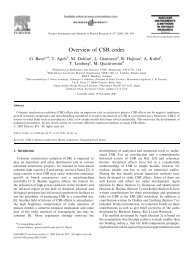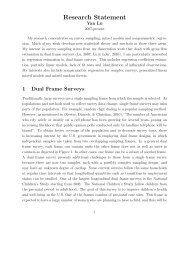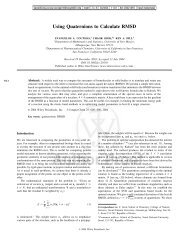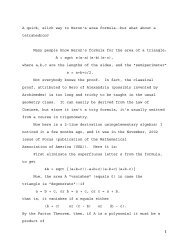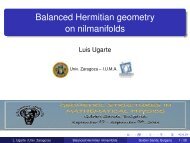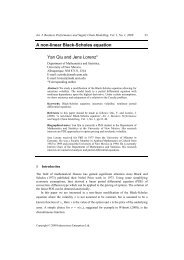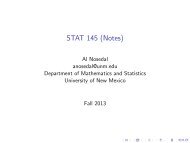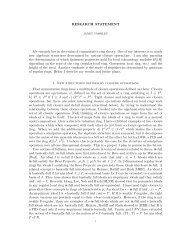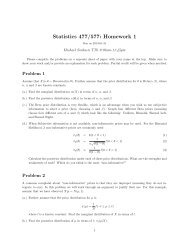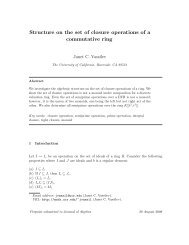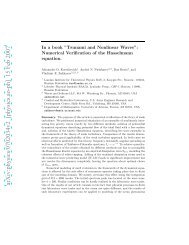Dyson's Lemma and a Theorem of Esnault and Viehweg
Dyson's Lemma and a Theorem of Esnault and Viehweg
Dyson's Lemma and a Theorem of Esnault and Viehweg
Create successful ePaper yourself
Turn your PDF publications into a flip-book with our unique Google optimized e-Paper software.
In order to prove <strong>Lemma</strong> 3.3 it will suffice to show that κ > d m . Suppose that this is notthe case. Then we can choose D α (P) ∈ J withD α (P) = ∑ u α,β (ξ)Q β (ξ), u α,β (η) ≠ 0, ∞, <strong>and</strong> |β| ≤ d m .Take D α (P) <strong>and</strong> β as above with |β| minimal. Then by (i) <strong>of</strong> <strong>Lemma</strong> 3.7 we see that∆ β [D α (P)](η) ≠ 0. But by (ii) <strong>and</strong> (iii) <strong>of</strong> <strong>Lemma</strong> 3.7 <strong>and</strong> the assumption that |β| ≤ d mwe see that ∆ β [D α (P)] ∈ I, a contradiction. Thus κ > d m .The pro<strong>of</strong> <strong>of</strong> <strong>Theorem</strong> 3.1 follows precisely the same model. Let η be a general point <strong>of</strong>C. Since <strong>Theorem</strong> 3.1 is local we can restrict to a small affine open subset U ⊂ X containingη; thus we can assume that the derivatives D α (s) are globally defined <strong>and</strong> that s can beidentified, via a local trivialization <strong>of</strong> L, with a function P s on U. By abuse <strong>of</strong> notation, westill denote by C the intersection C ∩ U <strong>and</strong> similarly the domain <strong>of</strong> all projections will betacitly assumed to be restricted to U. The argument <strong>of</strong> <strong>Lemma</strong> 3.3 goes through unchanged,yieldingWe claim thatD α (P s ) ∈ P dm+1C , for all 0 ≤ α i ≤m−1 ∑j=i+1[π −1{1,...,m−1} π{1,...,m−1} (C) ] ⊂ Z[D α (P s )] for all 0 ≤ α i ≤d j . (3.8)m−1 ∑j=i+1d j . (3.9)If (3.9) did not hold then there would exist a point P ∈ π {1,...,m−1} (C) <strong>and</strong> a multi–index αas in (3.9) such that D α ∣(P s ) ∣π −1 (P) is a local equation for a non–zero global section{1,...,m−1}<strong>of</strong> the sheaf L|P × C m . But (3.8) says that D α (P s ) ∣ ∣ ∣π−1{1,...,m−1} (P) has multiplicity ≥ d m + 1at at least one point <strong>and</strong> this contradicts Definition 0.2. Now choose a generic η ∈ C m sothat s|C 1 × · · · × C m−1 × η is a non-zero section <strong>of</strong> L|C 1 × · · · × C m−1 × η. By (3.9)π {1,...,m−1} (C) ⊂ Z ( D α [ P s |π −1m (η)]) for all 0 ≤ α i ≤m−1 ∑d jj=i+1<strong>and</strong> <strong>Theorem</strong> 3.1 follows by induction on m (since π {1,...,m−1} (C) is not contained in a properproduct subvariety).As a corollary <strong>of</strong> <strong>Theorem</strong> 3.1 we derive a rough analogue <strong>of</strong> [EV1] 5.5:Corollary 3.10 Suppose C ⊂ X is not contained in a proper product subvariety. Let j :C ֒→ X denote the natural inclusion. Then for α ≥ δ there exists a global section σ ∈H 0 [C, L ⊗ M(α) ⊗ j −1 I(s)].Pro<strong>of</strong>: <strong>Theorem</strong> 3.1 states that there is an α ≤ δ such that the meromorphic sectionD α (s)|C is non-zero. Since D α (s)|C is non-zero, (1.4) shows thath 0 [C, L ⊗ M(α) ⊗ j −1 I(s)] ≠ 0,<strong>and</strong> increasing α does not effect the conclusion <strong>of</strong> Corollary 3.10.In the special case X = P <strong>and</strong> L = O P (d) Corollary 3.10 has a more explicit statement<strong>and</strong> pro<strong>of</strong>:14



